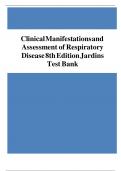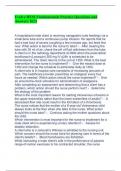Clinical Manifestations and
q q
Assessment of Respiratory
q q q
Disease 8th Edition Jardins
q q q q
Test Bank
q q
,Chapter q 01: q The q Patient q Interview
Des q Jardins: q Clinical q Manifestations q and q Assessment q of q Respiratory
qDisease, q 8th qEdition
MULTIPLE q CHOICE
1. The q respiratory q care q practitioner q is q conducting q a q patient q interview. q The
q main q purpose qof q thisinterview q is q to:
a. review q data q with q the q patient.
b. gather q subjective q data q from q the q patient.
c. gather q objective q data q from q the q patient.
d. fill q out q the q history q form q or q checklist.
ANS: B
The q interview q is q a q meeting q between q the q respiratory q care q practitioner q and q the
q patient. q It qallows q thecollection q of q subjective q data q about q the q patient’s q feelings
q regarding q his/her
condition. q The q history q should q be q done q before q the q interview. q Although
q data q can q be qreviewed, qthat q is q not q the q primary q purpose q of q the q interview.
2. For q there q to q be q a q successful q interview, q the q respiratory q therapist q must:
a. provide q leading q questions q to q guide q the q patient.
b. reassure q the q patient.
c. be q an q active q listener.
d. use q medical q terminology q to q show q knowledge q of q the q subject q matter.
ANS: C
NqbRqbIqbGqbB.CqbM
U qS qNqbtherapist
The q personal q qualities q that q a q respiratory qT O
q must qbhave q to q conduct q a q successful
q interview qinclude
being q an q active q listener, q having q a q genuine q concern q for q the q patient, q and q having
q empathy. q Leading q questions q must q be q avoided. q Reassurance q may q provide q a q false
q sense q of q comfort q to q the q patient. q Medicaljargon q can q sound q exclusionary q and
q paternalistic q to q a q patient.
3. Which q of q the q following q would q be q found q on q a q history q form?
1. Age
2. Chief q complaint
3. Present q health
4. Family q history
5. Health q insurance
providera. q 1, q 4
b. 2, q 3
c. 3, q 4, q 5
d. 1, q 2, q 3, q 4
ANS: D
Age, q chief q complaint, q present q health, q and q family q history q are q typically q found q on q a
q health q history q form q because q each q can q impact q the q patient’s q health. q Health
q insurance q provider qinformation, q whileneeded q for q billing q purposes, q would q not q be
q found q on q the q history q form.
,NURSINGTB.COM
, 4. External q factors q the q respiratory q care q practitioner q should q make q efforts q to
q provide qduring q an qinterview q include q which q of q the q following?
1. Minimize q or q prevent q interruptions.
2. Ensure q privacy q during q discussions.
3. Interviewer q is q the q same q sex q as q the q patient q to q prevent q bias.
4. Be q comfortable q for q the q patient
q and qinterviewer. qa. q 1, q 4
b. 2, q 3
c. 1, q 2, q 4
d. 2, q 3, q 4
ANS: C
External q factors, q such q as q a q good q physical q setting, q enhance q the q interviewing
q process. qRegardless q of q theinterview q setting q (the q patient’s q bedside, q a q crowded
q emergency q room, q an qoffice q in q the q hospital q or q clinic,qor q the q patient’s q home), q efforts
q should q be q made q to q (1) q ensure q privacy, q (2) q prevent q interruptions, q and q (3)secure q a
q comfortable q physical q environment q (e.g., qcomfortable q room q temperature, q sufficient
q lighting, q absence q of q noise). q An q interviewer q of q either qgender, q who q acts
q professionally, q should q be q able q to q interview q a q patient q of q either q gender.
5. The q respiratory q therapist q is q conducting q a q patient q interview. q The q therapist
q chooses qto q useopen-ended q questions. q Open-ended q questions q allow q the
q therapist q to q do qwhich q of q the q following?
1. Gather q information q when q a q patient q introduces q a q new q topic.
2. Introduce q a q new q subject q area.
3. Begin q the q interview q process.
4. Gather q specific q information.
a. 4 NURSINGTB.COM
b. 1,
q3
c. 1,
2, q 3
d. 2,
3, q 4
ANS:
qC
An q open-ended q question q should q be q used q to q start q the q interview, q introduce q a q new
q section q of qquestions,qand q gather q more q information q from q a q patient’s q topic. q Closed
q or q direct q questions q are q used q to q gather q specific q information.
6. The q direct q question q interview q format q is q used q to:
1. speed q up q the q interview.
2. let q the q patient q fully q explain q his/her q situation.
3. help q the q respiratory q therapist q show q empathy.
4. gather q specific
information.qa. q 1, q 4
b. 2, q 3
c. 3, q 4
d. 1, q 2, q 3
ANS: A
Direct q or q closed q questions q are q best q to q gather q specific q information q and
q speed q up q the qinterview. q Open- qended q questions q are q best q suited q to q let q the
q patient q fully q explain q his/her qsituation q and q possibly q help q therespiratory q therapist





